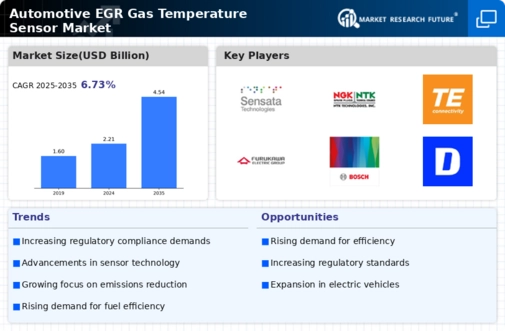Rising Environmental Regulations
The Automotive EGR Gas Temperature Sensor Market is significantly influenced by the rising environmental regulations aimed at reducing vehicular emissions. Governments across various regions are implementing stricter emission standards, compelling manufacturers to adopt advanced technologies that ensure compliance. EGR systems play a crucial role in minimizing nitrogen oxide emissions, and the sensors are vital for monitoring the effectiveness of these systems. As a result, the demand for EGR gas temperature sensors is expected to rise, with projections indicating a market growth rate of approximately 6 percent annually over the next five years. This regulatory landscape is likely to drive innovation and investment in the Automotive EGR Gas Temperature Sensor Market.
Growth of the Automotive Industry
The Automotive EGR Gas Temperature Sensor Market is closely linked to the overall growth of the automotive sector. As vehicle production increases, so does the demand for components that enhance engine performance and compliance with emission standards. The automotive industry is projected to grow at a compound annual growth rate of around 4 percent, which will likely boost the demand for EGR systems and their associated sensors. This growth is further fueled by the rising popularity of diesel engines, which utilize EGR systems more extensively. Consequently, the Automotive EGR Gas Temperature Sensor Market is poised for expansion as manufacturers seek to optimize engine performance and meet regulatory requirements.
Increasing Demand for Fuel Efficiency
The Automotive EGR Gas Temperature Sensor Market is experiencing a notable surge in demand driven by the increasing emphasis on fuel efficiency. As automotive manufacturers strive to meet stringent fuel economy standards, the integration of EGR systems has become essential. These systems, which recycle exhaust gases back into the engine, require precise temperature monitoring to optimize performance and reduce emissions. According to recent data, vehicles equipped with advanced EGR systems can achieve fuel savings of up to 10 percent. This trend is likely to continue as consumers increasingly prioritize fuel-efficient vehicles, thereby propelling the growth of the Automotive EGR Gas Temperature Sensor Market.
Shift Towards Hybrid and Electric Vehicles
The Automotive EGR Gas Temperature Sensor Market is also influenced by the shift towards hybrid and electric vehicles. While these vehicles typically produce lower emissions, the integration of EGR systems in hybrid models remains relevant for optimizing engine performance and efficiency. As automakers increasingly invest in hybrid technology, the demand for EGR gas temperature sensors is expected to rise. Furthermore, the transition to electric vehicles may lead to the development of new sensor technologies that can monitor alternative fuel systems. This evolving landscape presents both challenges and opportunities for the Automotive EGR Gas Temperature Sensor Market, as manufacturers adapt to changing consumer preferences and regulatory frameworks.
Technological Innovations in Sensor Technology
The Automotive EGR Gas Temperature Sensor Market is benefiting from rapid technological innovations in sensor technology. Advances in materials and design have led to the development of more accurate and reliable sensors, which are essential for the efficient operation of EGR systems. These innovations not only enhance the performance of the sensors but also contribute to the overall efficiency of the vehicle. For instance, the introduction of smart sensors with integrated diagnostic capabilities allows for real-time monitoring and predictive maintenance, which can reduce downtime and improve vehicle reliability. As these technologies continue to evolve, they are likely to drive further growth in the Automotive EGR Gas Temperature Sensor Market.

















Leave a Comment